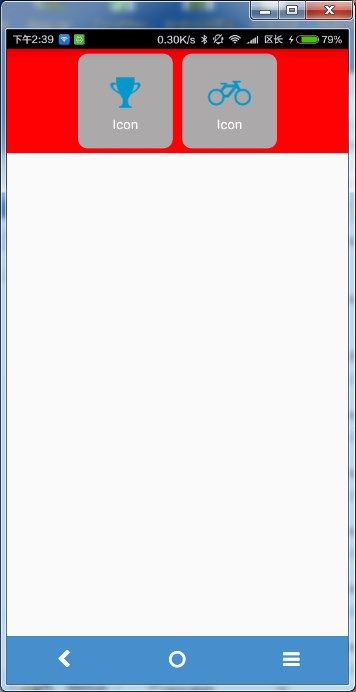Android React Native自定义组件的流程
假设我们现在有这么一个需求,就是自定义一个组件,该组件由一个小图标和图标的文字说明组成,并且带有背景色,背景色可设置,宽度高度可设置。如下图所示正是两个这样的组件所组成。
首先,在index.android.js目录下新建一个js文件,命名为item.js,在里面输入模板代码
/** * Sample React Native App * https://github.com/facebook/react-native */
'use strict';
var React = require('react-native');
var {
StyleSheet,
Text,
View,
Image,
} = React;
var Item = React.createClass({
render: function() {
return (
<View> </View> ); }, }); var styles = StyleSheet.create({ }); module.exports = Item;注意最后的一句module.exports = Item;,将组件导出。
我们的组件最外围应该是一个View,View里面嵌套了一个Image和Text,并且View,Image,Text都有对应的样式,图片地址还要可以设置,文本内容可设置,而View的背景色,高度,宽度等样式应该由外部传入,并且与组件内部的样式联合作用,这一点可以使用样式数组实现,即style={[style1,style2,style3]},最终,render函数中返回的信息如下。
<View style={[styles.item,outStyle]}> <Image style={styles.image} source={{uri:img}}/> <Text style={styles.text}>{text}</Text> </View>现在我们拿到外部设置的属性值
var outStyle={
width:parseInt(this.props.width),
height:parseInt(this.props.height),
backgroundColor:this.props.color,
}
var img=this.props.img;
var text=this.props.text;所以最终的代码是这样的
var Item = React.createClass({
render: function() {
var outStyle={
width:parseInt(this.props.width),
height:parseInt(this.props.height),
backgroundColor:this.props.color,
}
var img=this.props.img;
var text=this.props.text;
return (
<View style={[styles.item,outStyle]}> <Image style={styles.image} source={{uri:img}}/> <Text style={styles.text}>{text}</Text> </View> ); }, });在内部我们还要对其进行样式化
var styles = StyleSheet.create({
item:{
justifyContent:'center',
alignItems:'center',
borderRadius:10,
marginLeft:5,
marginRight:5,
marginTop:5,
marginBottom:5,
},
image:{
width:48,
height:48,
},
text:{
color:'#ffffff',
alignItems:'center'
}
});当然,这个View还可以提取很多属性为自定义的属性,本例子只是为了演示,所以提取了几个个别的属性
如何使用?
也很简单,要使用的文件中引入该组件,使用定义的标签,并设置对应的属性即可。
引入组件
var Item = require('./item');使用组件
var AwesomeProject = React.createClass({
render: function() {
return (
<View style={styles.container}>
<Item style={styles.item1} color='#aaa' width='100' height='100' text='Icon' img='https://raw.githubusercontent.com/lizhangqu/androidicons/master/assets/blue_dark/xhdpi/ic_action_achievement.png'></Item>
<Item style={styles.item2} color='#aaa' width='100' height='100' text='Icon' img='https://raw.githubusercontent.com/lizhangqu/androidicons/master/assets/blue_dark/xhdpi/ic_action_bike.png'></Item>
</View>
);
},
});
var styles = StyleSheet.create({
container:{
flexDirection:'row',
justifyContent:'center',
alignItems:'center',
backgroundColor:'#ff0000'
},
item1:{
marginLeft:100,
},
item2:{
marginLeft:100,
}
});可以看到我们在render函数中使用了Item标签,并在该标签中设置了自定义的属性,最终这些属性会被设置到我们的组件上去。
